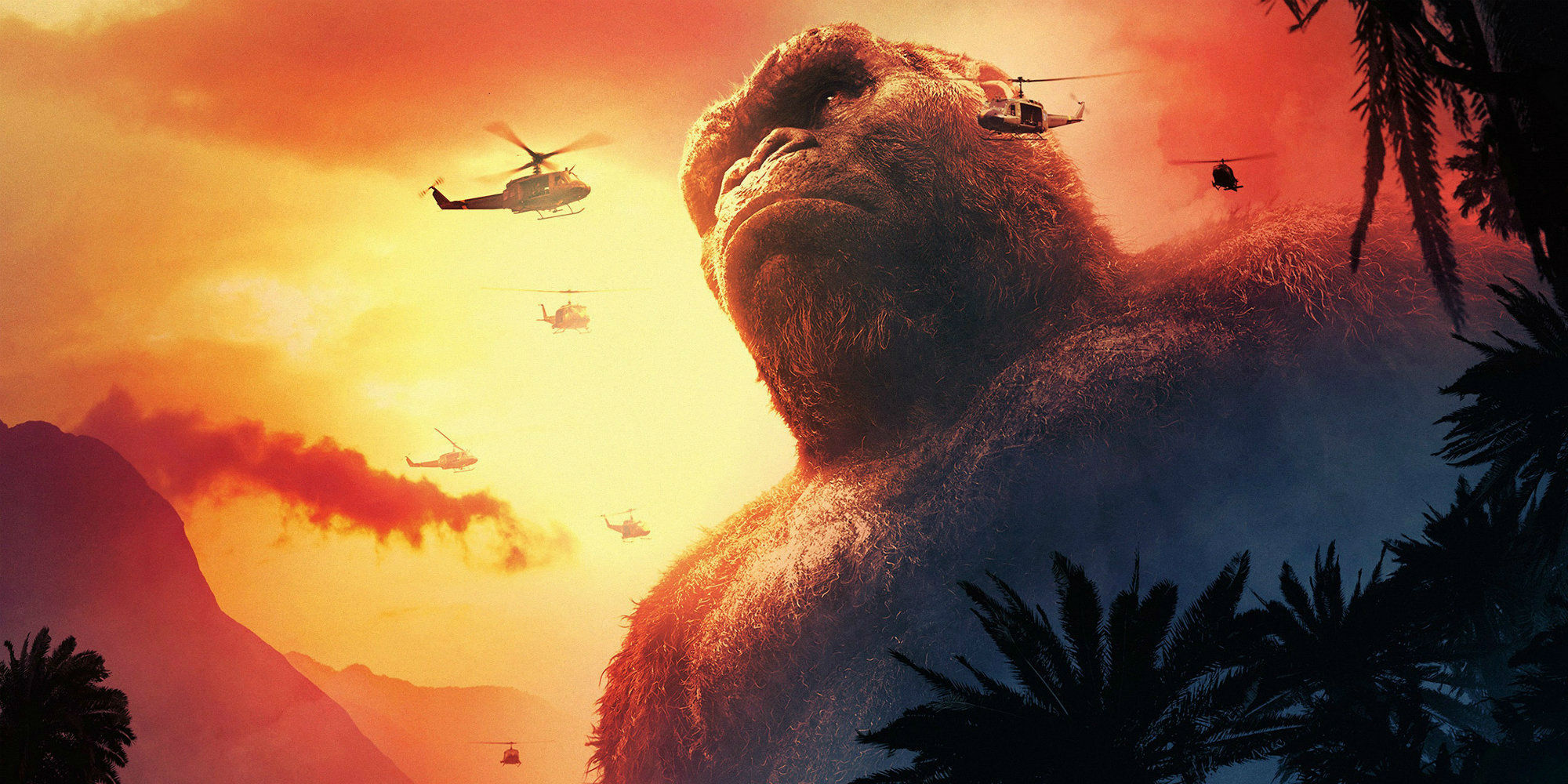Kong: Skull Island (2017, Dir. Jordan Vogt-Roberts):
“Monsters exist.” So says obsessed millionaire Bill Randa (John Goodman) halfway through Kong: Skull Island, and is there really anything more that needs to be said? No subtext, no hidden messages, no symbolism required. Welcome to the WYSIWYG (what you see is what you get) era of cinema, in which creatures wreak all manner of computer-generated havoc just for entertainment value alone. But Skull Island isn’t about another anonymous monster — this is King Kong, the granddaddy of them all, a primal beast fraught with all kinds of meanings if you go looking for them. Previous iterations of Kong have touched on fears of native savagery and black power, and even the lure of miscegenation (what’s a big black ape to do when the object of his affection is a shrieking white woman who ends up leading him to a literal and figurative fall?). This time, though, Legendary Pictures has only franchises and dollar signs in mind, and Kong: Skull Island, along with the recent Godzilla reboot, are positioning the studio for monster mash-ups galore. Think The Avengers, only with lunk-headed behemoths doing battle (hey, non-human actors take up way less payroll). Kong: Skull Island has only one thing on its mind: Send its audience on an amusement park-worthy ride.
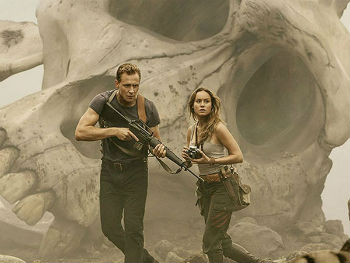 And as a ride, Skull Island isn’t horrible. It’s pulpier, and better, than Peter Jackson’s three-hour-plus King Kong (2005), which buckled under the weight of its own grandiosity. Clocking in at under two hours, this updated version of the Kong saga doesn’t pussyfoot around. While Kong in Jackson’s film was withheld from view for an hour while we were buried in exposition and ham-handed character development, Skull Island cuts to the chase, giving us a good look at the beady-eyed mug of our favorite simian in the first five minutes. After a teaser set in World War II that steals from John Boorman’s Hell in the Pacific, the movie jumps forward to 1973 and the close of the Vietnam War. Intent on proving there’s a place “where myth and science meet” and taking advantage of freshly available military resources, Goodman’s Randa wastes no time assembling a cast of mincemeat (er, characters) for his mission, including tightly-wound helicopter commander Packard (Samuel L. Jackson), a former British special forces hero gone to seed as a tropical tracker (Tom Hiddleston, perfectly coiffed even in the grime of the jungle), a politically conscious photojournalist (Brie Larson, ditto), and the usual mismatched crew of scientists and Army hard-asses. And yes, there’s a Chinese member of the expedition (Tian Jing) who really doesn’t do anything, but that ever-growing Asian movie market must be catered to.
And as a ride, Skull Island isn’t horrible. It’s pulpier, and better, than Peter Jackson’s three-hour-plus King Kong (2005), which buckled under the weight of its own grandiosity. Clocking in at under two hours, this updated version of the Kong saga doesn’t pussyfoot around. While Kong in Jackson’s film was withheld from view for an hour while we were buried in exposition and ham-handed character development, Skull Island cuts to the chase, giving us a good look at the beady-eyed mug of our favorite simian in the first five minutes. After a teaser set in World War II that steals from John Boorman’s Hell in the Pacific, the movie jumps forward to 1973 and the close of the Vietnam War. Intent on proving there’s a place “where myth and science meet” and taking advantage of freshly available military resources, Goodman’s Randa wastes no time assembling a cast of mincemeat (er, characters) for his mission, including tightly-wound helicopter commander Packard (Samuel L. Jackson), a former British special forces hero gone to seed as a tropical tracker (Tom Hiddleston, perfectly coiffed even in the grime of the jungle), a politically conscious photojournalist (Brie Larson, ditto), and the usual mismatched crew of scientists and Army hard-asses. And yes, there’s a Chinese member of the expedition (Tian Jing) who really doesn’t do anything, but that ever-growing Asian movie market must be catered to.
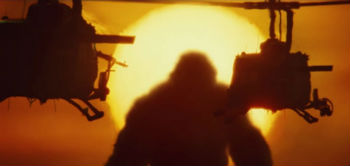 Give the filmmakers credit for this: they make sure the big palooka gets a hell of an entrance. The first setpiece is a doozy, as Kong takes on a flotilla of helicopters, looming in the sunset like an implacable mountain. Filmed for maximum impact, the battle seesaws back and forth between scale and intimate horror. One moment, helicopters and bodies are thrown in every direction, and in the next, little details throw us for a loop, like a Nixon bobble-head glued to a helicopter dashboard bouncing crazily just before the chopper hits the jungle floor. Some may yearn for the days in which men in gorilla suits got to do the dirty work, but there’s no denying that CGI has come a long way when it comes to sheer spectacle, and Kong’s first attack in Skull Island ranks among the finest episodes of monster mayhem in recent years.
Give the filmmakers credit for this: they make sure the big palooka gets a hell of an entrance. The first setpiece is a doozy, as Kong takes on a flotilla of helicopters, looming in the sunset like an implacable mountain. Filmed for maximum impact, the battle seesaws back and forth between scale and intimate horror. One moment, helicopters and bodies are thrown in every direction, and in the next, little details throw us for a loop, like a Nixon bobble-head glued to a helicopter dashboard bouncing crazily just before the chopper hits the jungle floor. Some may yearn for the days in which men in gorilla suits got to do the dirty work, but there’s no denying that CGI has come a long way when it comes to sheer spectacle, and Kong’s first attack in Skull Island ranks among the finest episodes of monster mayhem in recent years.
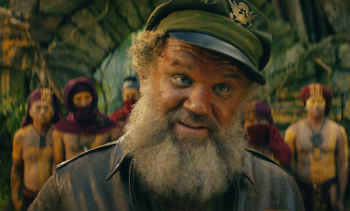 The production has a flourish or two up its sleeve: Cinematographer Larry Fong pulls some sumptuous scenic imagery from the Southeast Asian and Hawaiian locations, and a few scenes feature a heady mix of humor and suspense (the best involves a creature who has just eaten a man with a camera, the camera’s flash going off at constant intervals and alerting the monster’s would-be victims of its proximity). But as our protagonists get separated and we settle in with them for the long slog back to safety, the plot loses most of its momentum. While Hiddleston makes a game attempt to play tough as the nominal hero, the script isn’t interested in supplying him with much of a personality besides his name (Conrad, a clear nod to Joseph Conrad and Heart of Darkness). And before you can even say “Kurtz,” we stumble upon a character named Marlow (John C. Reilly), an addled World War II vet who has been stuck on the island for nearly three decades (apart from their names, how this all relates to Heart of Darkness is anyone’s guess). Effusive, tortured, and just plain nuts, Marlow is the closest thing the movie has to a rooting interest — and that’s the closest the script by Dan Gilroy, Max Borenstein and Derek Connolly gets to pathos. Somewhere in here is a commentary about the unintended consequences of invading native lands, and what happens when natives push back (Kong and Vietcong, anyone?), but all that is swept aside in favor of on-the-nose zingers like “That’s Kong. He’s king around here.” The rest of the movie, we’re stuck with these characters as they await or blunder into another creature ambush, amidst period-appropriate rock music, ham-fisted attempts at humor, and a few National Geographic-worthy landscapes. Director Jordan Vogt-Roberts is known primarily for directing TV comedies and Funny or Die episodes, and while he isn’t overwhelmed by the scale of the enterprise, he doesn’t provide any distinctive touches outside Marlowe’s sit-com-like jabberings. The less said about the other expendable cast members, the better, although it should be noted that Brie Larson, ostensibly the Fay Wray/Jessica Lange stand-in, only shares the screen with Kong for a few inoffensive scenes (the King even deigns to ignore her and rumble off at one point — like we said, no time for subtext).
The production has a flourish or two up its sleeve: Cinematographer Larry Fong pulls some sumptuous scenic imagery from the Southeast Asian and Hawaiian locations, and a few scenes feature a heady mix of humor and suspense (the best involves a creature who has just eaten a man with a camera, the camera’s flash going off at constant intervals and alerting the monster’s would-be victims of its proximity). But as our protagonists get separated and we settle in with them for the long slog back to safety, the plot loses most of its momentum. While Hiddleston makes a game attempt to play tough as the nominal hero, the script isn’t interested in supplying him with much of a personality besides his name (Conrad, a clear nod to Joseph Conrad and Heart of Darkness). And before you can even say “Kurtz,” we stumble upon a character named Marlow (John C. Reilly), an addled World War II vet who has been stuck on the island for nearly three decades (apart from their names, how this all relates to Heart of Darkness is anyone’s guess). Effusive, tortured, and just plain nuts, Marlow is the closest thing the movie has to a rooting interest — and that’s the closest the script by Dan Gilroy, Max Borenstein and Derek Connolly gets to pathos. Somewhere in here is a commentary about the unintended consequences of invading native lands, and what happens when natives push back (Kong and Vietcong, anyone?), but all that is swept aside in favor of on-the-nose zingers like “That’s Kong. He’s king around here.” The rest of the movie, we’re stuck with these characters as they await or blunder into another creature ambush, amidst period-appropriate rock music, ham-fisted attempts at humor, and a few National Geographic-worthy landscapes. Director Jordan Vogt-Roberts is known primarily for directing TV comedies and Funny or Die episodes, and while he isn’t overwhelmed by the scale of the enterprise, he doesn’t provide any distinctive touches outside Marlowe’s sit-com-like jabberings. The less said about the other expendable cast members, the better, although it should be noted that Brie Larson, ostensibly the Fay Wray/Jessica Lange stand-in, only shares the screen with Kong for a few inoffensive scenes (the King even deigns to ignore her and rumble off at one point — like we said, no time for subtext).
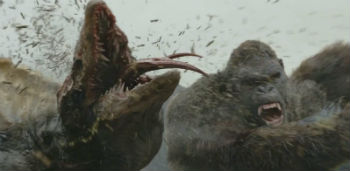 Let’s face it though, the humans are never the point when it comes to movies like these. If you’re just looking for tasty monster-on-monster showdowns, Skull Island fits the bill, but the busy-ness of the plot and the filmmakers’ focus on the island’s natural and unnatural dangers result in Kong coming off almost as an afterthought in his own movie. Whatever one can say about previous iterations of Kong, they all respected the mythic quality of the big guy. Fierce, unpredictable, his motives mostly unknowable, Kong has always been the id unleashed, and much of the power of his movies comes from the audience apprehending him in all his uncontrollable glory. Skull Island takes him in a more benign direction: in this story he’s neutered, a mostly benevolent protector of the Asiatic aborigines who reside on the island. By the time we reach the climax he’s merely another pawn in the plot’s ever-escalating need for monster showdowns, one half of the card for a title bout with a gargantuan creature from the bowels of the earth (or as Marlow helpfully announces, “That’s the big one”).
Let’s face it though, the humans are never the point when it comes to movies like these. If you’re just looking for tasty monster-on-monster showdowns, Skull Island fits the bill, but the busy-ness of the plot and the filmmakers’ focus on the island’s natural and unnatural dangers result in Kong coming off almost as an afterthought in his own movie. Whatever one can say about previous iterations of Kong, they all respected the mythic quality of the big guy. Fierce, unpredictable, his motives mostly unknowable, Kong has always been the id unleashed, and much of the power of his movies comes from the audience apprehending him in all his uncontrollable glory. Skull Island takes him in a more benign direction: in this story he’s neutered, a mostly benevolent protector of the Asiatic aborigines who reside on the island. By the time we reach the climax he’s merely another pawn in the plot’s ever-escalating need for monster showdowns, one half of the card for a title bout with a gargantuan creature from the bowels of the earth (or as Marlow helpfully announces, “That’s the big one”).
Kong: Skull Island concludes with a post-credits teaser that promises mundo monsters to come, and based on the results this time, you could be forgiven for wondering if these films will ever rise above being slick, mostly forgettable roller-coaster rides. Still, you can’t hold back the big ape forever, and try as the film might to divest itself of any kind of subtext, there’s still the sight of Samuel L. Jackson locking eyes with Kong after the latter has decimated his troops. In alternating shots we see their exchanged gaze: both savages, both enraged, both black, both vying for the title of King of the Jungle. It just goes to show that you can’t keep a good primal symbol down.

